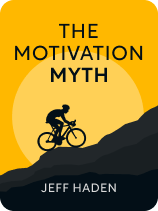

This article is an excerpt from the Shortform book guide to "The Motivation Myth" by Jeff Haden. Shortform has the world's best summaries and analyses of books you should be reading.
Like this article? Sign up for a free trial here.
How do you build the path to success? What is the first step you need to take to reach your goals?
If you’re stuck in your career or at school, it’s easy to feel like your dreams are a lifetime away. With the help of Jeff Haden’s book The Motivation Myth, you can set your path to success by preparing for the future and finding the right people to mentor you.
Let’s look at how you should prepare for any obstacles headed your way, while also celebrating small wins.
Preparing for Success
The first step toward reaching your goals isn’t finding motivation. To begin, you must first design the path to success that will help you build the momentum you’ll need to accomplish your objectives. We’ll cover Haden’s advice about finding a professional example on which to model your path and program for success and creating a routine that will kickstart you into action.
The hardest part of following a course of action is starting in the first place. Haden says that once you get over that initial hump, it’s much easier to keep moving toward your goal. What’s holding you back isn’t a lack of motivation, but rather a lack of preparation. Preparation gives you enough confidence to help you cross your first hurdles, after which, incremental success will slowly grow your motivation to keep going.
(Shortform note: In Switch, Chip and Dan Heath suggest that the difficulty you feel when starting toward a goal is caused by the friction between your rational and your emotional mind. Your emotional self responds most strongly to instant gratification, and the seemingly endless wait for the rewards of long-term goals can feel daunting to the point of distraction. The Heath brothers suggest designing your process to provide your emotional side with some form of gratification as quickly as possible, which is also what Haden goes on to recommend.)
When starting out, don’t focus on the end goal, whether that’s earning a college degree, winning a swimming competition, or writing a best-selling novel. Instead, try to imagine how good it will feel once you’ve got the ball rolling. Keep your mind on the next step toward your goal and the feeling of accomplishment your next small win will bring.
(Shortform note: When following Haden’s advice, don’t be discouraged by how small the individual steps might be. One striking example is the stroke recovery process Jill Bolte Taylor describes in My Stroke of Insight. After having a stroke and losing many of her cognitive functions, even a goal such as getting out of bed was a mighty achievement to be broken down in steps. Taylor writes that celebrating every microscopic victory was crucial to regaining her autonomy, just as Haden suggests when tackling what you perceive as larger goals.)
You should be careful, though, not to celebrate too soon. Haden writes that this usually happens when you let others know what you hope to achieve. With the intention of being supportive, they’ll often congratulate you in advance, which will simulate the feeling that you’ve already reached your goal. But the feeling that you’ve won the race before it’s started is nothing but an illusion, and people who experience it are less likely to follow through on the work needed to achieve real success. Instead of telling your friends what you wish to accomplish, talk about the steps you’ll take to get there. To do that, you’ll need to know what those steps are.
(Shortform note: Haden’s claim that talking about your goals is counterproductive comes from a psychological study published in 2009. However, more recent research shows that sharing your goals with others can create motivation through accountability, so long as the person you share with is someone you perceive to be more successful than you are. For example, talking about your ambitions to a supervisor, professor, or mentor creates what psychologists call “evaluation apprehension,” the feeling that you’re going to be judged on your progress if you don’t live up to your stated goals.)
Find a Teacher
To design your path to success, Haden suggests finding a high-achieving professional to emulate. Study how they achieved what you’re after, and determine the steps they took along the way. Haden stresses the difference between a professional and a coach, gives clues as to how to emulate their path to accomplishment, and suggests ways to place yourself in the right surroundings to gain access to a variety of professionals to learn from.
Haden recommends using a professional, not a coach, as a model because, unlike a coach, a professional won’t cheer you on or cut you any slack. A professional who isn’t a mentor by trade will simply explain what it takes to succeed and expect you to do it. The trick is to channel their experience and techniques. Once you’ve identified a person to emulate, you don’t even have to meet them in real life—just pick someone whose path you want to mirror, and do what they did without taking shortcuts. It’s not actually the person themself that you need but the program for success that they used.
Haden says to start by picking one thing your professional exemplar does that would point you toward your goal, then do it even if it seems to go against your normal behavior. If they’re a novelist, perhaps they wake up hours before you do to write while everyone else is asleep. If they’re a top-ranked public speaker, maybe they do vocal warmups every morning as part of their exercise routine. Whatever activity you select will stretch you in ways you aren’t accustomed to and will grow your skills in ways you might not have expected.
Build Your Program
Haden says the true purpose of designing a program is so that you can stop worrying about your goals at all. Instead, a good program will let you laser-focus on your next step and nothing else. Here, we’ll discuss how to choose a program to follow and how establishing a routine eliminates the need for willpower. We’ll also cover tips for how to maintain your focus.
Thankfully, when plotting your course, you don’t have to reinvent the wheel or rediscover fire. Chances are that whatever you aspire to, whether it’s to paint professional-level murals or to kayak down Class V rapids, someone else has already achieved it and mapped out a program to get there. You merely have to do your research and choose from the many different programs available. Haden suggests that you shouldn’t waste time fretting over which program is the most ideal for you because you have no way of knowing until you’ve started. The advantage of any good program toward success is that it lays out every step you need to take, saving you the time and effort of figuring it out for yourself.
The next vital component is to turn your program into a routine. By making your efforts toward your goal automatic, a routine negates the need for motivation. Without a routine, every day and moment means you must consciously choose whether to follow your program or do something else, such as binge-watch TV or play games on your phone. Having to make that choice depletes your will and makes it more likely that you won’t follow through. However, if you establish a routine that keeps you on your program, you’ll no longer have to decide what to do. Followed long enough, a routine makes the steps toward your goal a part of your identity—it’s not just what you do, it’s who you are.
Establishing a routine is easier said than done. Haden offers several tips to make it less of an uphill battle:
- Redesign your workspace to eliminate distractions (such as putting away your phone and closing your door so you won’t be interrupted).
- Place reminders of your overall goal, such as sticky notes and photos, in places where they’ll interrupt temptations (such as on your refrigerator or in front of your TV).
- Keep healthy snacks easily available (such as fruits, vegetables, or nuts) to keep your energy levels from flagging.
- At the end of each day, plan out the next one, so you won’t have to spend that energy in the morning. Use that start-of-day energy instead to tackle your hardest task first.

———End of Preview———
Like what you just read? Read the rest of the world's best book summary and analysis of Jeff Haden's "The Motivation Myth" at Shortform.
Here's what you'll find in our full The Motivation Myth summary:
- Why you should stop waiting for motivation to hit and instead, make your own
- How to create a cycle of positive reinforcement to boost your motivation
- How to develop resilience to get through times of struggle






